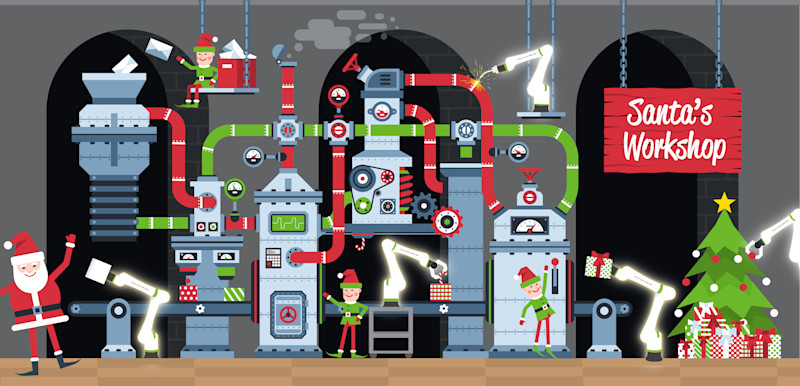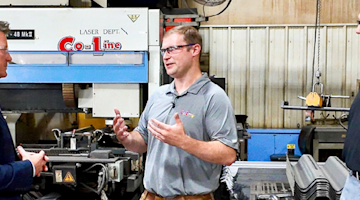The labor shortage is impacting manufacturing shop owners around the world, even Old St. Nick. Santa’s Workshop, a North Pole-based toy manufacturer and distributor, has implemented robots throughout its facility to handle a growing workload with fewer workers.
“A lot of my long-time elf employees are retiring, and it’s hard to get new elves to relocate to one of the coldest places on Earth, so we’ve been desperate to find help this year,” Santa Claus, owner of Santa’s Workshop, says. “Automation was the logical solution to help us overcome some of our biggest challenges.”
The Workshop produces toys all year that are then delivered to 396 million households at Christmas. It is, by far, the world’s biggest single-day global shipping event.
Help for elves
In January, Claus contacted a local robot integrator to discuss automating some of the Workshop’s toy production lines. Although skilled elves are necessary for designing and manually building most of the traditional toys, there are many jobs around the shop that don’t require elf intelligence and creativity.
For example, all year long, several elves were loading and unloading production machines during their entire shifts. This task was not only repetitive but very boring, causing some elves to seek other, more engaging jobs. Some elves packed toys into boxes for storage until delivery day, and a couple full-time elves were solely focused on of palletizing boxes and putting them into warehouse racking.
Adding cobots
Now, Santa’s Workshop has a fleet of 6-axis, 10kg collaborative robots (cobots) mounted on carts that are moved to different lines throughout the Workshop. At any time, the cobots may be loading and unloading parts for production machines or packaging toys. Grippers on the robot arms are easily changed out to accommodate different sized toys.
In addition, a new robotic palletizing cell features a robotic arm with a 2,800 lb. payload that stacks boxes into whatever format is needed so they can be neatly stored away. Since adding the robots, the Workshop has seen a 25% increase in productivity and a significant boost in employee retention.
The Elf factor
For Claus, the biggest benefit to using cobots is creating a better work environment for the elves. With the dull jobs out of the way, elves have more time to build toys, check them for quality control, and tend to the reindeer. Also, there’s less chance of injuries due to repetitive motion and heavy lifting.
“It’s a more satisfying work experience for the elves, which is very important to me,” Claus says. “They’re not just coworkers but family.”
Expanding automation
Claus has considered adding automated guided vehicles (AGVs) to the warehouse to assist with staging loads at the dock, which is currently an exhausting, all-hands-on-deck situation for the elves. Automated forklifts would alleviate that headache.
“I’ve got my sights on a couple robotic narrow aisle forklifts for next year,” Claus says. “Then the elves will have more time to kick up their feet and enjoy some hot cocoa at the end of a busy year. They deserve it.”
“Thanks to cobots, all presents will be delivered on time and on budget – giving children a very Merry Christmas,” Claus says.
To explore what cobots, robots, automation, and other manufacturing technology can do for you, visit IMTS.com/ExhibitorSearch.






